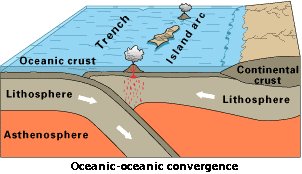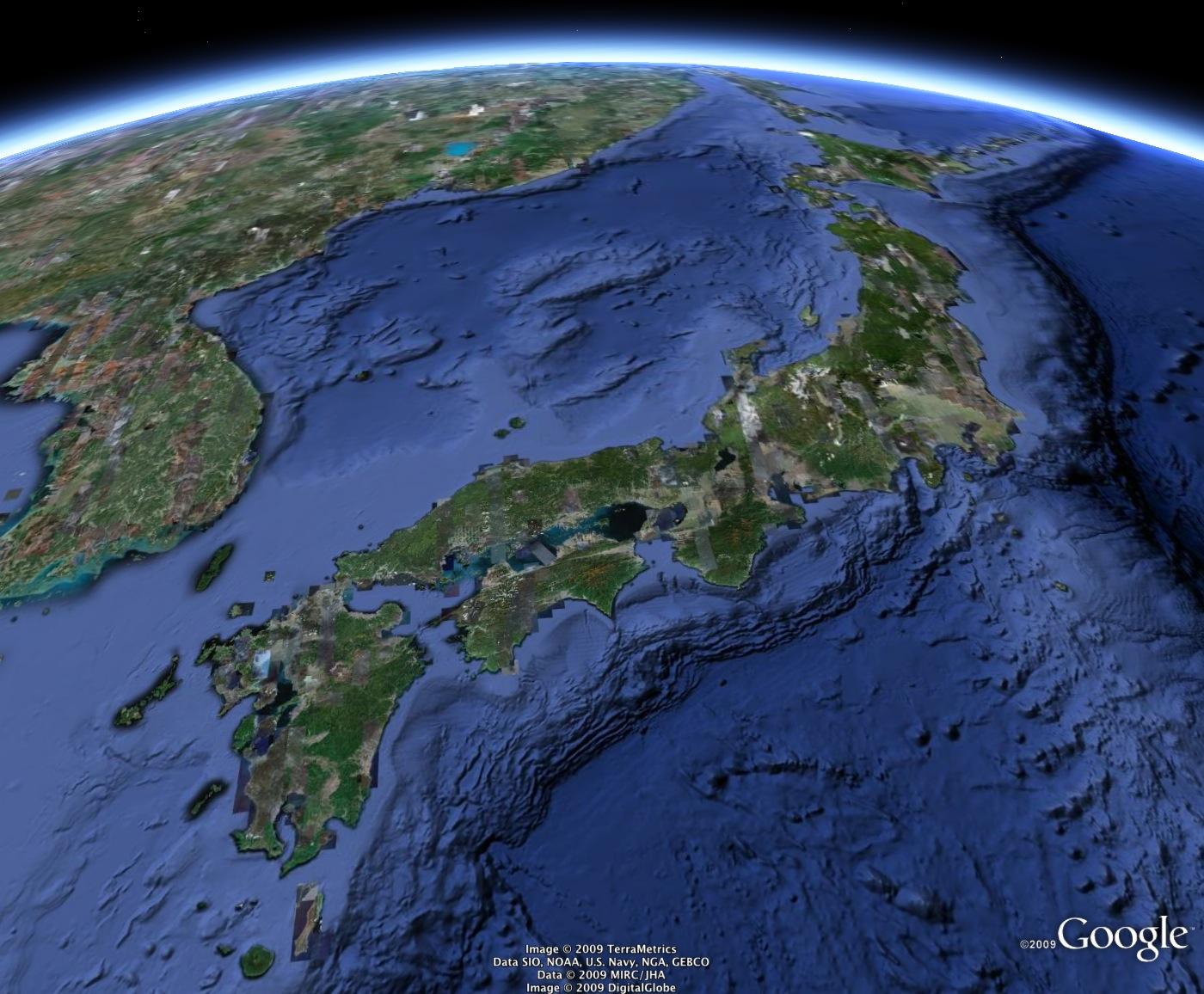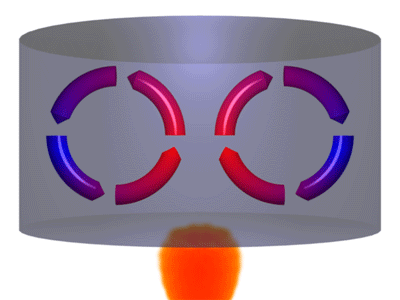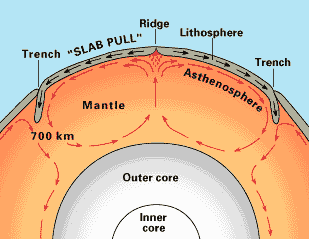Plate Tectonics
Plate Tectonics
Vine and Matthew's discovery of the magnetic striping on the sea floor showed that Hess' idea of sea-floor spreading was correct; oceans and continents moved together and the mid ocean ridges actually are areas where new ocean floor is created. Furthermore, continents do not drift, they move across the surface as a result of convection and so the theory of Plate Tectonics was born.
According to the theory of plate tectonics the lithosphere consists of variable-sized pieces called lithospheric plates (or plates) that move as a unit. Lithospheric plates can be composed of continental lithosphere and/or oceanic lithosphere. Oceanic lithosphere consist of oceanic crust which is mostly basaltic (having a composition similar to basalt, a maffic igneous rock) in composition with an average density of 3.0 g/cc. Continental lithosphere consist of continental crust which is granitic (having a composition similar to granite, a felsic igneous rock) in composition and has an average density of 2.7 g/cc.
As new sea floor is created at ridge systems plates on either side of the ridge are pushed outward, away from the ridge. Since the Earth is spherical this means that plates must interact with each other at some point beyond the ridges. Plates can interact in three ways. They can separate from one another such as what happens at ocean ridges, along divergent boundaries; they can collide at convergent boundaries; or plates can slide past each other along transform boundaries.
Divergent Boundaries
Divergent boundaries occur anywhere two plates are separating from each other and new oceanic lithosphere is formed. As suggested by Hess, this is due to upwelling magma that causes the crust to bulge and, as a result, thin and fracture. Once the crust fractures more magma can be formed by decompression and the partial melting of the mantle. The magma that forms rises through the crust into vertical fractures to form dikes and may also erupt on the surface.
Divergent boundaries that form within continents create rifts. A rifts is an area of faulting (breaking of rock) that forms as a result of the horizontal tension caused by spreading beneath the continent. As the rift grows and the continent continues to spread eventually the continent can be split in two, creating an ocean basin between the two sides and ridge system between them.Since Earth's volume cannot increase, as new ocean floor is created in one location old ocean crust must be destroyed in another. As ocean crust moves further and further away from a ridge it cools. As it cools it becomes denser and eventually begins to sink back into the mantle. This process, where old ocean crust sinks is called subduction. During subduction, oceanic plate descends beneath the margin of another plate. Eventually, the subducting plate moves into the asthenosphere where it is gradually heated, melted, and incorporated back into the the mantle. Wherever two plates collide if at least one plate is oceanic, subduction will occur.
Convergent Boundaries
Convergent plate boundaries form wherever two plates are colliding. Depending on the nature of the two interacting plates a number of different features may form on Earth's surface. In all cases convergent plate boundaries are characterized by severe deformation, where rock layers are folded and faulted to form mountain ranges, much like what may occur to the hood of a car during an accident. There are three types of convergent plate boundaries; oceanic-oceanic, oceanic-continental, and continental-continental.
 |
| Diagram depicting an oceanic-oceanic convergent boundary |
Ocean-oceanic convergent plates boundaries form whenever two oceanic plates collide. Since both plates are oceanic subduction will occur causing the older, colder (denser) plate to sink beneath the other. As a result of the subduction process a trench forms between the two plates indicating where one plate intersects the other. As the subducting plate continues to sink deep ocean sediments are scraped of the subducting plate and pile up along the margin of the non-subducting plate, this is called an accretionary wedge. As the subducting plate continues to sink increased pressure and temperatures cause partial melting of the subducting plate. The magma produced as a result of partial melting then begins migrating upward through the non-subducting plate. When the magma erupts at the surface a volcanic island arc is formed on the non-subducting plate. If subduction occurs at a fast enough rate frictional forces between the two plate margins may begin to drag the non-subducting downward, as a result the non-subducting plate becomes thinned and stretched producing a bowl shaped depression behind the volcanic island arc called a back arc basin.
The satellite image below shows the islands of Japan. In the image the Japanese Trench is clearly visible to the right of Japan. Just off eastern coast of Japan (the right side) you can also see the deformed ocean sediments forming the accretionary wedge. The islands of Japan were formed by the rising magma produced from the partial melting of the Pacific plate and therefore represent the volcanic island arc. To the left of Japan the Sea of Japan occupies a bowl shaped depression between Japan and China that is the back arc basin.
 |
| Google Earth image of Japan |
Oceanic-continental convergent plate boundaries are very similar to oceanic-oceanic boundaries except that one plate is continental. Since oceanic crust has density of 3g/cc and continental crust has a density of only 2.7g/cc whenever oceanic crust collides with continental crust the oceanic crust subducts. As a result, off the coast of the continental crust a trench will form indicating the subduction zone and oceanic sediments will be scraped off the subducting plate to form the accretionary wedge. As the oceanic plate continues to subduct the increased temperatures will cause partial melting and the resulting magma will rise through the non-subducting continental crust to form a volcanic arc along the margin of the continent.
 |
At Continental-continental convergent plate boundaries both interacting plates have densities of 2.7 g/cc, so neither plate will subduct. However, before the continents collided they were most likely separated by an ocean basin that subducted beneath the margin of one of the continents. During that subduction process ocean sediments would have accumulated along the trench forming an accretionary wedge. Once the ocean basin was completely subducted this wedge would be squeezed between the two colliding continents along the suture zone. Since both plate margins are buoyant neither plate will subduct. As result, these collisions cause material along the margins to become extremely deformed, much like a car's hood during a car crash, forming mountain ranges.
Deep within the uplifting mountains the extreme heat and pressure causes the andesitic continents to partially melt producing granitic magmas that are much to viscous to erupt. Instead, the buoyancy of these magmas force the mountains to rise even higher and eventually become emplaced as granite batholiths.
Mechanisms of Plate Tectonics
 |
| Convection in a warm liquid |
What distinguishes Plate Tectonics from continental drift is the fact that plate tectonics finally was able to explain how continents moved across the surface of our planet. The greatest contributing factor causing plates to move is the process of convection. Convection causes warm, buoyant fluids (represented in red in the image to the left) to rise due to their decreased density while cool, denser fluids (blue) sink. This is the same process that makes the wax inside a lava lamp to rise and sink.
 |
| Diagram depictingone possible mechanism of plate tectonics |
There are two models that are currently proposed to describe convection with the mantle. In one model convection is restricted to the asthenosphere. In the second, model the entire mantle is involved in convection. In either case spreading centers (divergent boundaries) would be located between the rising limbs of the convection cells and subduction zones and trenches would be located where the convection cells descend back into the earth's interior.
In addition to convection geologists also believe that the processes of slab-pull and ridge push enhance plate movement. Both of these processes are gravity driven but are dependent on the thermal processes of convection. In slab-pull the the sinking denser pulls the entire plate downward as it descends into the asthenosphere. Ridge push operates in conjunction with slab pull. As a result of the rising magma at spreading centers ridges
